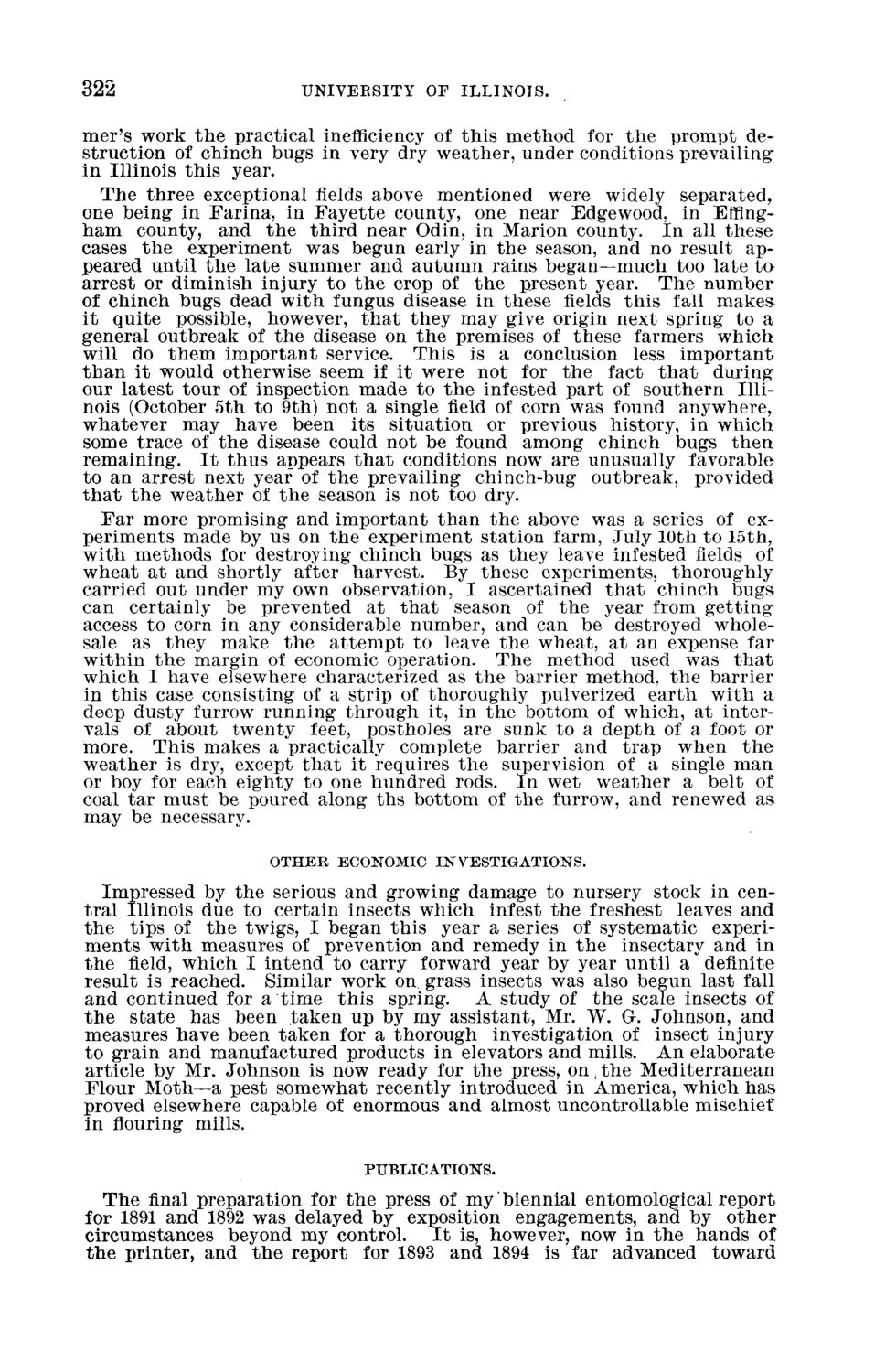| |
| |
Caption: Board of Trustees Minutes - 1894
This is a reduced-resolution page image for fast online browsing.

EXTRACTED TEXT FROM PAGE:
322 U N I V E R S I T Y OF ILLINOIS. mer's work the practical inefficiency of this method for t h e prompt destruction of chinch bugs in very dry weather, under conditions prevailing" in Illinois this year. The three exceptional fields above mentioned were widely separated, one being in Farina, in Fayette county, one near Edgewood, in Effingham county, and the third near Odin, in Marion county. In all these cases t h e experiment was begun early in the season, and no result appeared until t h e late summer and autumn rains began—much too late t a arrest or diminish injury to t h e crop of t h e present year. The number of chinch bugs dead with fungus disease in these fields this fall make* it quite possible, however, t h a t they may give origin next spring to a general outbreak of the disease on the premises of these farmers which will do them important service. This is a conclusion less important t h a n it would otherwise seem if it were not for the fact t h a t during our latest tour of inspection made to the infested part of southern Illinois (October 5th to 9th) not a single field of corn was found anywhere, whatever may have been its situation or previous history, in which some trace of the disease could not be found among chinch bugs then remaining. I t thus appears t h a t conditions now are unusually favorable to an arrest next year of t h e prevailing chinch-bug outbreak, provided t h a t t h e weather of the season is not too dry. F a r more promising and important than the above was a series of experiments made by us on the experiment station farm, July 10th to 15th, with methods for destroying chinch bugs as they leave infested fields of wheat at and shortly after harvest. By these experiments, thoroughly carried out under my own observation, I ascertained t h a t chinch bugs can certainly be prevented at that season of the year from getting access to corn in any considerable number, and can be destroyed wholesale as they make the attempt to leave the wheat, at an expense far within t h e margin of economic operation. The method used was t h a t which I have elsewhere characterized as the barrier method, the barrier in this case consisting of a strip of thoroughly pulverized earth with a deep dusty furrow running through it, in the bottom of which, at intervals of about twenty feet, postholes are sunk to a depth of a foot or more. This makes a practically complete barrier and trap when t h e weather is dry, except t h a t it requires the supervision of a single man or boy for each eighty to one hundred rods. I n wet weather a belt of coal tar must be poured along ths bottom of the furrow, and renewed a* may be necessary. OTHER ECONOMIC INVESTIGATIONS. Impressed by the serious and growing damage to nursery stock in central Illinois due to certain insects which infest the freshest leaves and the tips of the twigs, I began this year a series of systematic experiments with measures of prevention and remedy in t h e insectary and in the field, which I intend to carry forward year by year until a definite result is reached. Similar work on grass insects was also begun last fall and continued for a time this spring. A study of t h e scale insects of t h e state has been taken up by my assistant, Mr. W. G-. Johnson, and measures have been taken for a thorough investigation of insect injury to grain and manufactured products in elevators and mills. An elaborate article by Mr. Johnson is now ready for the press, on, the Mediterranean Flour Moth—a pest somewhat recently introduced in America, which has proved elsewhere capable of enormous and almost uncontrollable mischief in flouring mills. PUBLICATIONS. The final preparation for the press of my biennial entomological report for 1891 and 1892 was delayed by exposition engagements, and by other circumstances beyond my control. I t is, however, now in the hands of the printer, and t h e report for 1893 and 1894 is far advanced toward
| |